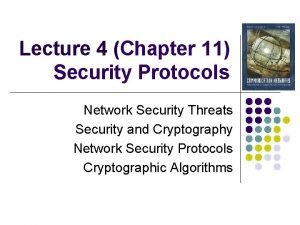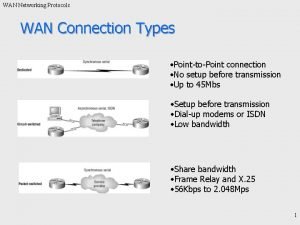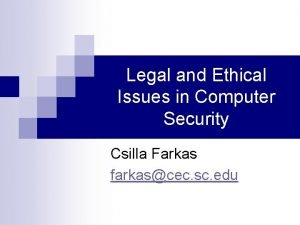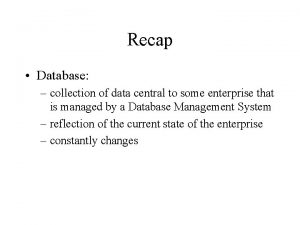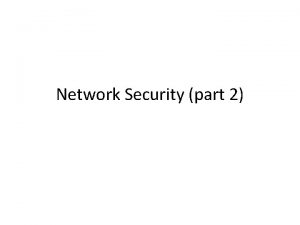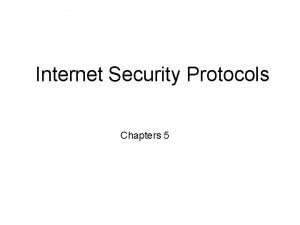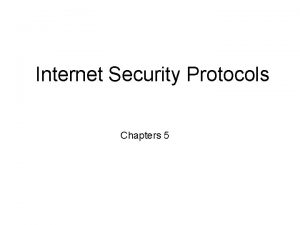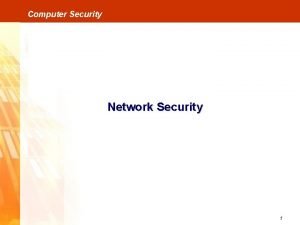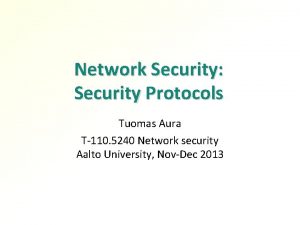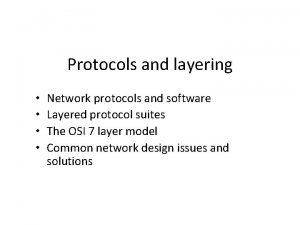Network security Further protocols and issues Protocols recap






























- Slides: 30

Network security Further protocols and issues

Protocols: recap • There a few main protocols that govern the internet: – Internet Protocol: IP – Transmission Control Protocol: TCP – ICMP – UDP • Most of these were designed before security was even an issue, and hence are fundamentally insecure.

IP Spoofing • IP protocol doesn’t prevent anyone from lying about the source address. • Simple utilities exist to do this – it is also done for testing and other legitimate purposes. • Simple packet filtering is the best defense – outside attacker then can’t spoof an inside address. • But IP is just inherently insecure!

Ingress filtering • Proposal to have every router drop packets with “invalid” IPs • Would eliminate spoofing if everyone did it, and is commonly used • However: – Source based – No incentives – Everyone must deploy

IPSec • Protocol that authenticates and encrypts each IP packet in a communication – Host to host or network to network or host to network, depending on setups • Provides data integrity, authentication, data confidentiality, and replay protection by using cryptography and a number of other protocols

IPSec workings • Authentication header: – Protects integrity and data origin authentication – Can also defend against replay attacks

IPSec workings • Encapsulating security payload – Provides origin authenticity, integrity and confidentiality

IPSec workings • Security association – The bundle of algorithms and parameters (such as keys) that is being used to encrypt and authenticate in one direction. • (So usually 2 per session. )

ICMP • The Internet Control Message Protocol exists to provide error reporting and testing to IP. • Primarily used by network devices like routers to send error messages. – Example: When the TTL field reaches 0, a message is sent to source address. • Many common utilities are built on this – traceroute, ping, etc. • Often blocked except from certain trusted sources.

UDP: User Datagram Protocol • UDP builds on top of IP by supporting port routing: – Destination port number gets a UDP data field that adds application process – Source port number provides a return address • Minimal guarantees – no acknowledgements, flow control, or anything • In a sense, not easy to attack, but not reliable anyway!

TCP: adding reliability • TCP preserves order and adds reliability: – Sender breaks data and attaches number – Receiver must acknowledge receipt, so lost packets are resent and packets are reassembled

A bit more complex:

Some attacks on TCP • TCP states can be easy to guess – And hence spoofed or fooled • TCP connection requires state, which means the server has to remember something – TCP Syn floods can then overrun memory – Denial of service is easy on this protocol! • More details…

Force TCP Session Closing • Suppose an attacker can guess the sequence number for an existing connection – Then send reset packet to close connection (so DOS) – Can naively guess (1/232 chance) – Most systems allow for some window of sequences, however, so much easier • This is especially successful against long lived connections (like BGP, etc. ), especially combined with packet sniffing

TCP Spoofing • Each connection for TCP has some state associated – Client/server IP and port – Sequence numbers • Problem: easy to guess this state – Ports are standard – Sequence numbers stored in predictable way

Session Hijacking • Need a degree of unpredictability to avoid attacks. • If the attacker knows initial sequence number and rough amount of traffic, easier to guess, and can flood with likely numbers. • Some vulnerabilities are unavoidable, but simple randomization can make things harder.

SYN flood • Attacker sends a ton of syn packets but no acks (or can use falsified IP so response will be ignored) • Server must remember all of these connections, so quickly runs out of space

SYN cookies • Invented by Dan Bernstein, the idea defeat SYN floods is to use “particular choices of initial TCP sequence numbers”. • Essentially, the server doesn’t have to remember the connection, but can instead reconstruct the query from the TCP sequence number. • Some restrictions – can’t accept some TCP options, and still some limits, but overall fairly successful.

Denial of service attacks • “Any attack that prevents or impairs the authorized use of networks, systems, or applications by exhausting resources such as CPU, memory, bandwidth, or disk space” – Can be local or network based • A Distributed DOS attack is a network based attack which uses multiple hosts

DDo. S • Attacker compromises and uses other machines • Can spoof IPs to further complicate • Attack network or host resources • Long and active history…

DDo. S reflector attack • Put victims IP as source address in many requests • The “reflector” machines then flood the victim • Advantages: – Hides source – Amplifies the attack • Successfully used many times

Smurf Do. S attack • Attacker sends ICMP packets on broadcast mode with victim’s address as source. • On broadcast mode, everyone will then reply to that IP.

DDo. S defenses • Packet filtering and monitoring • Change defaults – no ICMP broadcast anymore (mostly) • Incorporate SYN cookies • ISP filtering and traffic scrubbing • “Overprovision” servers • CAPTCHAs:

Intrusion detection/prevention • Deeper analysis and monitoring of network traffic, with content analysis – Network based – Host Based • Examples: – Snort – Verisys – Tripwire – Etc.

Detection methods • Misuse signature based detection – E. g. SNORT rules • Anomaly detection – Port scan detection • Combine well with firewalls, but usually more complex – Issues of resources and cost, allocation, separation of resources

Evasion techniques • Fragmentation: attack will go “under the radar” and bypass detection • Avoid defaults: IDS may expect trojans on particular ports, so configure to use different ports • Low bandwidth attacks – e. g. stealth port scanning • Address spoofing • Pattern change and evasion

Attacks on NIDS • Insertion attacks: – NID systems actually keep “bad” packets that everyone else drops – This can actually be a vulnerability!

Attacks on NIDS • Evasion attacks: – End system can accept a packet that the NIDS rejects.

Not quite this simple… • In reality, it’s not quite this easy, but these simple ideas have been used in a multitude of ways on different systems. • Examples: – Bad headers – Unusual IP options – Even MAC addresses in the local network

Next time • Higher level protocols and their insecurities: DNS and BGP • Worms and Botnets • Onion routing and higher level (newish) constructions • Homework: read “required reading” section of lab by Thursday!
 Network security protocols
Network security protocols Network security protocols
Network security protocols Wireless security in cryptography
Wireless security in cryptography Privat security
Privat security Osi security model
Osi security model Guide to network security
Guide to network security Electronic mail security in network security
Electronic mail security in network security Security guide to network security fundamentals
Security guide to network security fundamentals Security guide to network security fundamentals
Security guide to network security fundamentals Network topologies and protocols
Network topologies and protocols Chapter 3 network protocols and communications
Chapter 3 network protocols and communications The most complex part of tls is the
The most complex part of tls is the E commerce security and fraud issues and protections
E commerce security and fraud issues and protections Types of wan
Types of wan Wireless sensor network protocols
Wireless sensor network protocols Network communication protocols map
Network communication protocols map Key points of romeo and juliet
Key points of romeo and juliet Legal and ethical issues in computer security
Legal and ethical issues in computer security Legal and ethical issues in computer security
Legal and ethical issues in computer security Attack sophistication vs intruder technical knowledge
Attack sophistication vs intruder technical knowledge Legal and ethical issues in information security
Legal and ethical issues in information security The shawshank redemption movie summary
The shawshank redemption movie summary The great gatsby chapter 8-9 summary
The great gatsby chapter 8-9 summary What is price matching
What is price matching What is the purpose of an iteration recap?
What is the purpose of an iteration recap? Recap intensity clipping
Recap intensity clipping 60 minutes recap
60 minutes recap Recap database
Recap database Bracket power rule
Bracket power rule Sample script for recapitulation
Sample script for recapitulation Recap introduction
Recap introduction

